Live From 2019 FIFA Women’s World Cup: Efforts Rise, Excitement Abounds for Final
The FIFA TV team and HBS see production improvements pay off
Story Highlights
Sunday night’s FIFA Women’s World Cup Final between Netherlands and the United States brings to a close a month-long showcase for some of the best athletes in the world. Ratings have been up, often impressively, compared with 2015. The quality of play and competitiveness of the matches have also improved. And for the FIFA TV team and HBS, the appointed host broadcaster for this event, behind-the-scenes improvements have paid off.
The two semifinals and final have been played at the home of women’s football in France, the 57,900-seat Stade de Lyon. It was a fitting location, and, with enough compound space for both an expanded unilateral presence by rightsholders and the FIFA TV multilateral production at the core of the matches, it became the de facto home of a number of activities the final week.
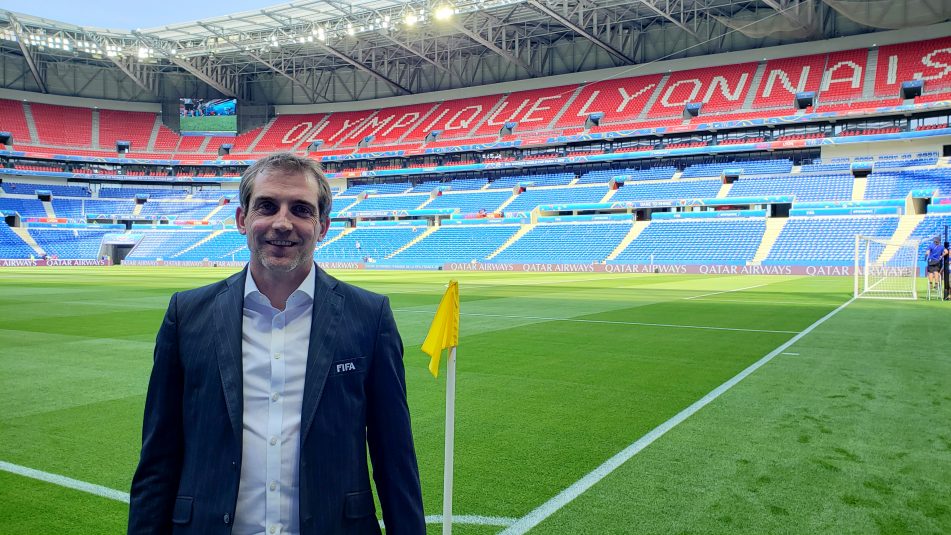
FIFA TV’s Neil Darroch is pitchside at Stade de Lyon, home of the semifinals and final of the 2019 FIFA Women’s World Cup.
“The IBC in Paris is still fully staffed, but the difference this week was that Lyon became the main FIFA and LOC headquarters,” says Neil Darroch, senior manager, TV operations, FIFA TV. “It allows us to support the venue team with the increased attention and activates around the final matches and makes it easier for us to manage some of the things face-to-face.”
The final week’s matches have seen an uptick in the number of cameras deployed. A helicopter shot, cable cam, and an external camera mounted on a 60-meter crane and used primarily to receive transmissions from the helicopter are making a difference from above; an ultra-slow-motion Polecam behind each goal and a super-slow-motion camera level with the 6-meter line in front of each goal will make a difference on the pitch.
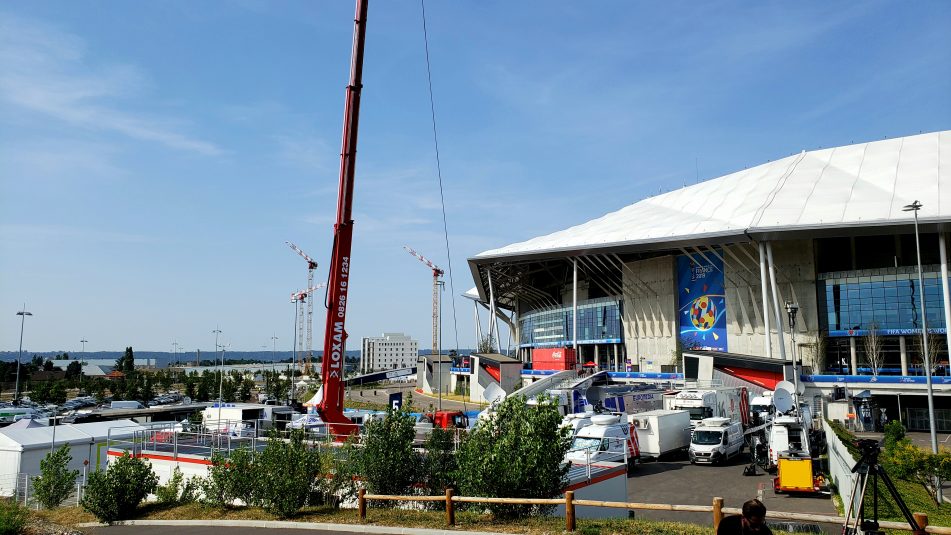
The TV compound outside the Stade de Lyon
“We picked a camera plan for all of the matches that ensured a high level of coverage, and we found that it could fit every stadium,” says Darroch of the challenge of outfitting coverage for venues that vary in seating capacity by as much as 30,000 fans. “Some stadiums had better locations for certain cameras than others, but they all host football or rugby matches on a regular basis, so the main camera positions were where we needed. For some, we needed to kill a few seats or upgrade a platform, but, in general, they were all the right size.”

From left: Telemundo’s Sammy Sadovnik, Ana Jurka, Carlota Vizmanos, and Viviana Vila are onsite for the 2019 FIFA Women’s Final on Sunday and have been in Lyon since the first semifinal last Tuesday.
Among the rightsholders with an expanded onsite presence is Telemundo, which moved its studio-production team from Paris to Lyon and is operating in an enclosed studio with a great view over the pitch and stadium. Unlike the rooftop location in Paris, the facility is climate-controlled and free of weather conditions that were often challenging. German public broadcasters ARD/ZDF, England’s BBC, and NOS Netherlands, and Canal+ France each have staked a claim in three open-air studio locations inside the stadium.
“There is a tendency towards wanting to do outside presentation studios,” says Darroch. “So we need to find locations to do large outside studio presentations that also capture the unique atmosphere of a Women’s World Cup.”
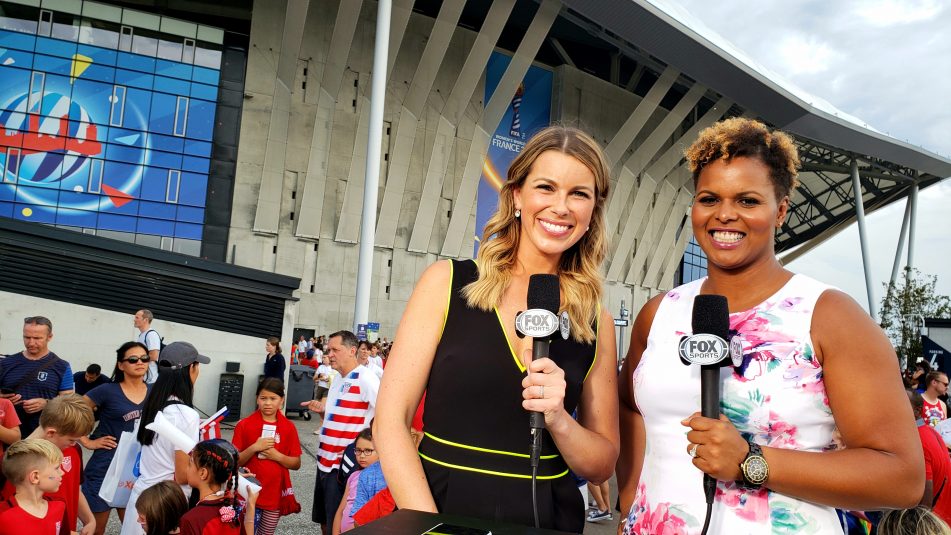
Co-hosts Fox Sports’ Jenny Taft and CONCACAF’s Karina LeBlanc were within selfie distance at the World Cup Semifinals and Final.
Fox Sports also has a small outside studio on the plaza as fans walk into the stadium. The two-camera shoot is integrated into the main studio show, which is still produced out of the Trocadéro-based studio in Paris.
“The LOC, FIFA, and HBS worked hard to give us the shot that we had always talked about and that we were looking for,” says Kevin Callahan, vice president, World Cup technical operations, Fox Sports. “It was fantastic, and, when the fans are outside the stadium, that is so much a part of this sport and this event.”
The Stade de Lyon location proved to be a boon prior to the U.S.-England match. U.S. fans gathered behind the set to give it an enthusiastic atmosphere that is uniquely American. And co-hosts Jenny Taft and Canadian five-time World Cup veteran and CONCACAF Head of Women’s Football Karina LeBlanc were within selfie distance, giving fans a digital souvenir to share with friends and family back home.
For the final today, the energy is likely to be amped even higher as two rabid fan bases, the American Outlaws and the Orange fans from Netherlands, descend on the stadium wearing red, white, blue, and orange.
“We always talk about how we want to be there to ‘Get the color of the event,’” says Callahan. “This is going to literally be color that we’re talking about.”
Other rightsholder improvements include expanded pitchside presentation opportunities, which are available behind each goal and also on both sides of the touchline. “Now a rightsholder can get into a position with their team warming up behind them,” says Darroch. “They can stay in their position longer, until just before the teams come out, resulting in a better product.”
Another major challenge for all rightsholders is getting interviews with players and coaches before and after matches. FIFA TV has taken steps to improve that as well, asking teams to make a player, not just a coach, available for a prematch interview.
“It enriches the content as they have a different perspective from the coach,” says Darroch, adding, “The teams have been really cooperative as the athletes are well-trained for media interviews. And it’s important [in promoting] the athletes as there are only a handful who are well-known globally.”
The FIFA team also took steps to keep the tunnel cleaner for the important walk that the teams make onto the pitch. Previously, lights and cameras could be set up prior to the match, but now only pre-cabling is allowed prior to the start of the second half.
“They can only set up during the second half,” says Darroch. “The result is a beautiful, clean shot when the teams are coming out, allowing the focus to be on the players, who are the stars.”
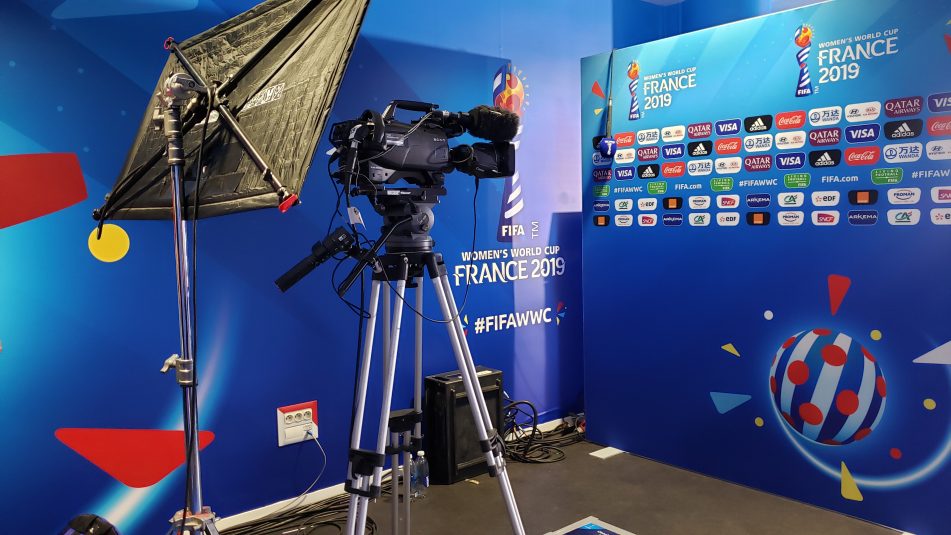
Improved interview areas at the FIFA Women’s World Cup is making a difference for all involved.
Stade de Lyon also offers plenty of space for a mixed zone, which serves as an extension of the flash area for prematch interviews. In addition, a prebuilt room is available as a studio for longer postmatch or sit-down interviews.
“Some rightsholders have a specific style of show they like to produce,” Darroch notes. “That studio offers a cabled, soundproof studio with backdrops that they can use.”
Another enhancement is the mixed zone taking place immediately after the flash interviews, located inside the stadium where media can line up and grab interviews with players.
“Within 15 or 20 minutes after the match, the players come through here so that reporters can get quotes and file their stories,” says Darroch. “Previously, they would have to wait for the players to shower and come out of the dressing room, which could take much longer. But now, within 30 minutes, the athletes can get back into the dressing room and have completed their TV and media activities. It has worked out great and is something we will look to continue for other events as it is the right way forward to serve the media. It’s made a big difference.”
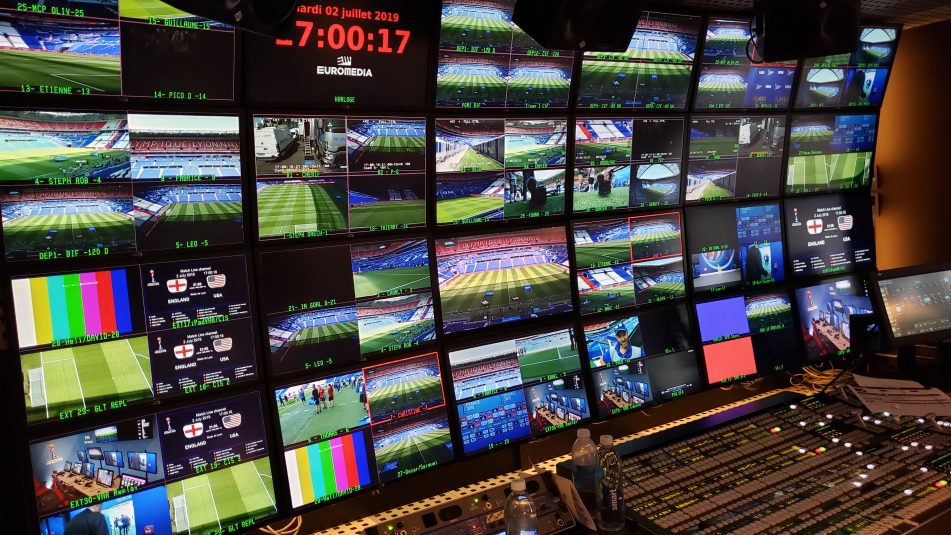
The front bench in Euromedia’s OB unit will be in high gear for the 2019 FIFA Women’s World Cup Final.
After the tournament concludes on Sunday night, it will be interesting to see if the boost in ratings and interest in the event translates into true growth of the game and fanbases. The 2020 Olympics are not far away and will give another bump to the women’s soccer fanbase around the globe.
When the next edition of the FIFA Women’s World Cup comes around in 2023, FIFA TV will likely once again raise the production a notch, embrace new workflows, and new technologies. Some of its decisions depend on broadcasting trends around the globe, but the goal will once again be to grow the game.
“As much as this is about showcasing the women’s game on TV, this is the pinnacle for all of the players who come here,” says Darroch. “If they’re working that hard on the pitch, we should be doing the same off the pitch.”
